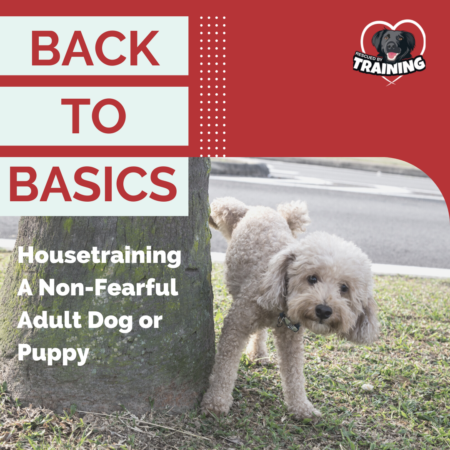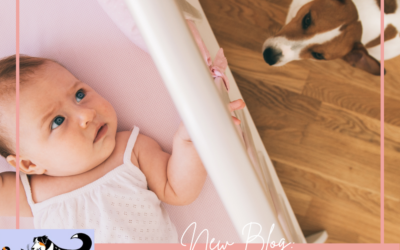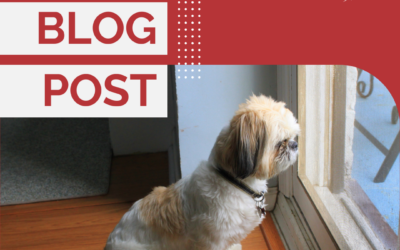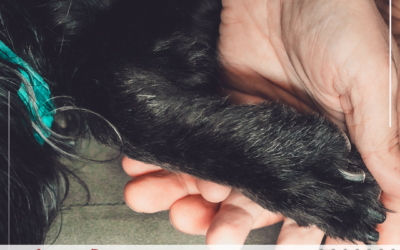Many people, whether they have a new puppy or a newly rescued adult dog, struggle with the most basic of things we need to train in dogs – to go to the bathroom outside. Housetraining or potty training can be frustrating for owners. Housetraining issues can be super frustrating and really zap the joy out of having a new puppy or dog in your home. Nobody likes to clean up constant messes or live with pee and poop. Dogs don’t instinctively know to relieve themselves outside and we definitely don’t want them going inside! So what do we do? (Please note: This process is for non-fearful dogs. For fearful dogs and dogs who are afraid to go outside read this post.)
- Crate train (or otherwise closely confined or tethered to you). Dogs are generally scrupulously clean animals. They do not want to potty where they are hanging out or sleeping. This is why we use appropriately sized crates for housetraining. Crates prevent the dog from having opportunities to make a mistake and teaches the dog to hold it. And I get it – you don’t like the idea of crating. You want your dog to have freedom to explore and play. But for an un-housetrained dog, this gives the dog permission to potty inside. The dog can potty, move away from it and go on playing and enjoying himself without having to hold his bladder or bowels and not be near it. And remember crating isn’t forever, but confining the dog is essential to housetraining.
- Track your dog’s schedule. Knowing when your dog pees and poops can help you get on a regular schedule for them. You can use an app like Puddle and Pile or you can just track it on your own.
- Reward immediately after the dog goes potty outside. This requires you accompany your dog to potty so you can be right there cheering and feeding as soon as they finish. If you wait for the dog to potty and then come over to you and then you feed, then the dog is being rewarded for coming to you, not for pottying.
- Loosen up management after 3 weeks of no accidents. Once you’ve followed strict crating and rewarding outside, you can begin to loosen up those confinement times after 3 straight weeks of no accidents. This still requires supervision but the dog can move to an x-pen enclosure or baby gated area instead of being in the crate for long periods of time.
- Never punish a dog for pottying inside. Not only will this not help your housetraining progress but it could entirely derail it. Punishing a dog for pottying (even scolding or saying “No!”) can cause reverse housetraining, where the dog becomes afraid to potty in front of people, even outside. The dog will sneak off and potty out of view of people, for fear of being yelled at or punished for going to the bathroom. How awful to live in fear of needing to potty!
- Don’t take the dog out too frequently. I understand. You don’t want the dog to have accidents so you take them out every 30-60 minutes. But that can be detrimental long term. It’s important their bodies learn that muscle memory. If you’re taking the dog out too frequently, they’re not training their body to hold it.
- Never restrict access to water as a means for housetraining. Increased water consumption can be an early indicator for many medical issues. And cutting off a dog’s access to water is inhumane and won’t teach them to potty outside. I had a puppy for board and train once and she was drinking a lot and struggling with housetraining, even with me. When I started measuring her water intake, she was drinking over 4 times what she should have been. Had I restricted her water, I wouldn’t have noticed this pattern.
When is it time to go to the vet?
If your dog was perfectly housebroken and suddenly is having accidents, get a vet check. If your dog or puppy is drinking more than they should for their weight (normally dogs drink 1/2-1 ounce of water per pound) then that also requires a vet check. While this isn’t my go-to for un-housetrained puppies, monitoring water intake is important. The puppy I mentioned above, sure enough, she was vet checked and had a UTI, and they knew to get her checked because of the increased water consumption. If you’re doing all the right things and your puppy is still unable to hold it and is having accidents, a vet check might be in order.
Let’s work together this year and help you and your dog succeed. You can schedule a session so we can review things in more detail.
Happy training!
![]()




